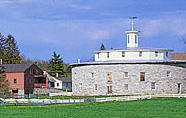
HANCOCK, MA -- In most dining places, an invitation to step back in time means someone thought a Laura Ashley decor or a bunch of old bric-a-brac would create a certain mood.
Here at the Hancock Shaker Village, you literarally are treading historic boards.
The offering of a candlelight Shaker dinner and tour lured me to this
charming spot on Route 20 midway between New Lebanon, NY, and Pittsfield, MA, a half-hour drive east of Albany, New York's capital city.
The village was one of 18 established as religious communities by the
Shakers in eight states after the death in 1784 of sect founder Ann Lee, who is buried near the site of the present Albany International Airport.
At its apogee, this 2,000-acre community had about 250 members. The movement declined after the late 1800s, and the last Shakers left the village in 1960. (A group of less than a dozen Shakers still lives in the Sabbath Day Lake community in Maine.)
At that point, a group of local people purchased the community and its 21 remaining buildings. It now is run as a not-for-profit educational organization. The village itself has been designated a National Historic Landmark.
The candlelight dinner series, held throughout the summer and fall, is anything but an eat-and-run affair. Plan for a fascinating 3 1/2-hour session of talks that will take you into the lives of the Shakers at various stages of the movement, tours of different aspects of the village, a communal dinner in the Believers' Dining Room, and a music program after dinner.
The round stone barn is often used as the icon for the village promotions, but the Brick Dwelling is the key structure, an impressive multi-storied one, built in 1830 to house nearly 100 Shaker brothers and sisters.
The celibate community kept the sexes separate but fully equal, and the dwelling duplicates nearly all living functions -- one side for women, the other for men in a fascinating mirror image architectural style. For the candlelight dinner, the sexes mix at the long tables, 16 to a table with four tables in the room; but, in Shaker days men sat on one side of the room, women on the other.
The food for these events is prepared by local specialty caterers and brought to the village for serving. The caterer's kitchen modifies some of the Shaker recipes for modern preferences as needed, but stays as true as possible to the originals.
The affair begins in the Meeting Room, sometimes called the chapel, of the Brick Dwelling with iced tea and an orientationby the two guides -- one male, one female, of course. The group is split into two mixed groups for walking tours, then participants reassemble in the kitchen of the Brick Dwelling to chat about what they've seen, over iced tea or excellent hard cider from the West County Winery at at Pine Hill Orchards in nearby Colrain, MA.
The dinner menu, served family-style, varies each week. For my visit, it consisted of a light garden salad wirh a basic vinaigrette, followed by a peppery herb broth, robust with cilantro, dill, summer savory, oregano, parsley, thyme and rosemary; and baskets of moist, yeasty bread accented by lemon zest.
The main course was Sister Clymena's Chicken Pie, accompanied by herbed rice, glazed carrots and green beans with dill weed. The chicken pie was a delight, although the serving size was skimpy -- tender chunks of breast meat and button mushroom slices in a tarragon-heavy cream sauce with a hint of brown sugar, all contained in a flaky crust.
Other weeks, the main item may be pot roast with cranberries, ham baked in cider, or roast lamb with ginger and cider. An alternative low-fat item is available if ordered in advance. The night I visited, it was a breaded, broiled chicken breast entree.
The meal finishes wirh slabs of dense honey cake topped with vanilla ice cream, and coffee or tea. That night, the coffee was a bit weak and not very hot. But, that is hardly enough to quibble about in the totality of a good meal.
After dinner, we returned to the Meeting Room -- once again segregated by gender -- to learn about the Shaker religious services and to hear a capella songs (the Shakers did not use musical instruments) and participate in a few activities with some visitors volunteering to execute Shaker dance steos under staff supervision.
I could have gone on for another hour.
ON THE WEB
• Our 2005 New England Dining Guide
• Our 2005 Cape Cod Dining Guide
